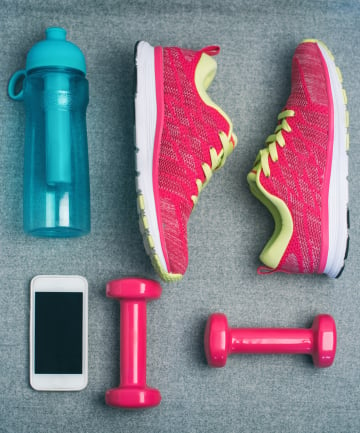It's good to have goals, but make sure you're being good to yourself in your fitness endeavors. Your priority shouldn't be quantity of reps and hours put in at the gym, but rather form.
"Pushing your body too hard when it is fatigued is a major mistake," says Lauren Zoeller, a yoga instructor & CTA-certified life balance coach. "Try your best to take a moment to listen to your body before working out. If you are too fatigued from a workout the day before, take a rest day. Your body needs time to repair itself."
Rachel Piskin, a fitness instructor and the co-founder of ChaiseFitness, agrees. She says, "To see results you do not need to workout every day. In fact, if you do not give yourself the proper rest between workouts, you will start to compensate form and use your muscles improperly which brings on the risk of injury."
Image via Lauren Zoeller
"Pushing your body too hard when it is fatigued is a major mistake," says Lauren Zoeller, a yoga instructor & CTA-certified life balance coach. "Try your best to take a moment to listen to your body before working out. If you are too fatigued from a workout the day before, take a rest day. Your body needs time to repair itself."
Rachel Piskin, a fitness instructor and the co-founder of ChaiseFitness, agrees. She says, "To see results you do not need to workout every day. In fact, if you do not give yourself the proper rest between workouts, you will start to compensate form and use your muscles improperly which brings on the risk of injury."
Image via Lauren Zoeller
Injuries can also be the result of poor form. For example, if you experience mild or major lower back pain immediately following a workout and in the days that follow, that's a sign your form isn't good.
"When your lower back is in pain immediately following a workout, chances are that you are not engaging your opposing abdominal muscles. Weak abdominals will force your lower back to handle the load of added weight, which can cause unnecessary stress on your spine," explains Zoeller. "Practice adding one abdominal exercise in between each weight rep to turn on your core. Also, before each weighted set, actively engage your abdominal muscles before picking up your weights."
If you have access to a fitness instructor, speak with them before, during, or after your workout to see if they can help perfect your form. Lots of fitness classes are led by an instructor who will be happy to assist you.
Image via Emilija Manevska/Getty
"When your lower back is in pain immediately following a workout, chances are that you are not engaging your opposing abdominal muscles. Weak abdominals will force your lower back to handle the load of added weight, which can cause unnecessary stress on your spine," explains Zoeller. "Practice adding one abdominal exercise in between each weight rep to turn on your core. Also, before each weighted set, actively engage your abdominal muscles before picking up your weights."
If you have access to a fitness instructor, speak with them before, during, or after your workout to see if they can help perfect your form. Lots of fitness classes are led by an instructor who will be happy to assist you.
Image via Emilija Manevska/Getty
Weak or sore knees are another sign that your form has room for improvement, says Zoeller.
"Your knees could be internally or externally rotating during squats. If you continually rotate in or out during any sort of squat exercise, you are adding added stress to your knee joint," she explains. "Look in a mirror and take an unweighted squat at a slow pace [and observe if] your knees roll in towards your big toes (internal rotation), or out towards your little toes (external rotation). If you begin to notice internal or external rotation, practice doing unweighted squats slowly until you are able to squat straight down without internal or external rotation."
Again, it's all a matter of pacing yourself and focusing on technique.
Image via seksan Mongkhonkhamsao/Getty
"Your knees could be internally or externally rotating during squats. If you continually rotate in or out during any sort of squat exercise, you are adding added stress to your knee joint," she explains. "Look in a mirror and take an unweighted squat at a slow pace [and observe if] your knees roll in towards your big toes (internal rotation), or out towards your little toes (external rotation). If you begin to notice internal or external rotation, practice doing unweighted squats slowly until you are able to squat straight down without internal or external rotation."
Again, it's all a matter of pacing yourself and focusing on technique.
Image via seksan Mongkhonkhamsao/Getty
There's a fitness myth that says cardio is the only way to lose calories, but that's simply not true. Worse, that mentality might even be holding you back.
"People often focus too much on cardio and the idea of losing weight and burning fat," says Piskin. "What they don't focus on is building a balance in their workouts between cardio and strength training. It is that balance between the two that allows you to see great transformation."
Image via Jose Luis Pelaez Inc/Getty
"People often focus too much on cardio and the idea of losing weight and burning fat," says Piskin. "What they don't focus on is building a balance in their workouts between cardio and strength training. It is that balance between the two that allows you to see great transformation."
Image via Jose Luis Pelaez Inc/Getty
You may think that purposeful breathing is just a thing that yogis do, but it's super important to get enough oxygen while exercising.
"Feeling dizzy or lightheaded during a workout could mean that you are not breathing correctly and that you are over-exerting yourself. It's a sign that you're not getting enough oxygen to your brain," says Zoeller. Yawning is an early sign that you're not getting enough air, too. It's your body's way of pulling in as much as possible.
The fix is to be purposeful about your breathing and to even incorporate it as part of your workout. For example, breathe in as you lift the dumbbell and breath out as you lower it. Or, breath in deeply for two counts of a run and then out for two.
"Also, work on listening to what your body is feeling," advises Zoeller. "If you begin to feel lightheaded then take a break, drink water, or practice square breath to bring your breath back to a normal state. To execute square breath, take a moment to close your eyes and visualize the four sides of a box. While you practice this breathing exercise, visualize tracing a box with your mind's eye as you breathe. Breath in for a count of four, hold your breath for a count of four, exhale for a count of four, and hold your breath for a count of four."
Image via Richard Drury/Getty
"Feeling dizzy or lightheaded during a workout could mean that you are not breathing correctly and that you are over-exerting yourself. It's a sign that you're not getting enough oxygen to your brain," says Zoeller. Yawning is an early sign that you're not getting enough air, too. It's your body's way of pulling in as much as possible.
The fix is to be purposeful about your breathing and to even incorporate it as part of your workout. For example, breathe in as you lift the dumbbell and breath out as you lower it. Or, breath in deeply for two counts of a run and then out for two.
"Also, work on listening to what your body is feeling," advises Zoeller. "If you begin to feel lightheaded then take a break, drink water, or practice square breath to bring your breath back to a normal state. To execute square breath, take a moment to close your eyes and visualize the four sides of a box. While you practice this breathing exercise, visualize tracing a box with your mind's eye as you breathe. Breath in for a count of four, hold your breath for a count of four, exhale for a count of four, and hold your breath for a count of four."
Image via Richard Drury/Getty









